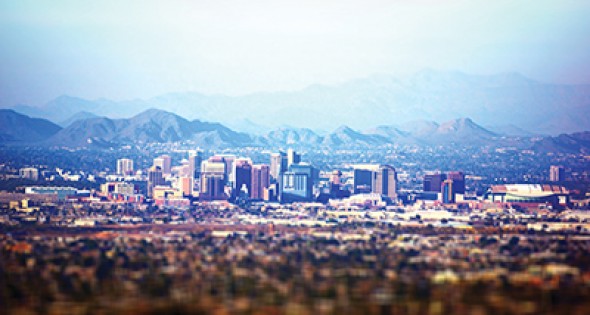
Arizona: Pro-Business Growth Agenda
19 Sep, 2016
By Lori Culpepper
Arizona’s economy is projected to outpace U.S. economic growth over the next several years as the state’s population, employment and personal incomes are expected to increase faster than the national average. With a favorable tax and regulatory climate and an ideal location, Arizona is actively pursuing a pro-business growth agenda.
Businesses in Arizona find a low-cost tax structure, less regulation and a higher-education system focused on creating a talented workforce. The state’s growth agenda includes tax and economic development incentives and programs to assist with job training, job creation, research and development, facilities construction and expansion, energy conservation and capital investment.
Glenn Hamer, the president and CEO of the Arizona Chamber of Commerce and Industry says they have modeled their economic development tools, tax reform, regulatory reform and tort reform on best practices from across the country.
As the number of technology, aerospace, defense and bioscience companies making Arizona their home increases, science, engineering, mathematics and technology jobs are projected to number 166,000 by 2018.
To meet the needs of that accelerating job market, Arizona has created a wide variety of skilled workers and a growing influx of talent. National rankings place Arizona second in workforce quality and availability and first in higher-education degree output. Among the state’s differentiators is an integrated approach to developing talent for employers in need of specialized skills.
Combined with the state’s quality of life, the rapidly growing employment market is attracting workers from around the country, and in 2012, the state ranked third in terms of population migrating into the state from the other 49 states.
Arizona’s most important and fastest-growing sectors include: technology and innovation; aerospace and defense; bioscience and health care; and advanced manufacturing.
Arizona’s technology sector is comprised of a wide variety of companies employing cutting-edge technology, and the state is home to a number of specialized IT clusters, including educational software, nanotechnology and photonics. Aerospace and defense employment is projected to increase by 10% annually through 2018. Major defense contractors, such as Raytheon, Boeing, General Dynamics and Honeywell have received more than $6 billion in defense contracts for work being undertaken in the state. This year, the University of Arizona’s College of Medicine will open a $100 million cancer center expansion. Apple recently decided to expand to Arizona with the opening of a cutting-edge facility that will manufacture next-generation glass for its consumer products. The plant will add to a manufacturing employment base that exceeded 154,000 jobs in 2013.
Another important aspect of Arizona’s economy is that it is the only state immediately accessible to Mexico, Texas and California, three of the world’s largest economies. The state fosters cross-border relationships through organizations such as the Arizona-Mexico Commission, a strategic partnership with Sonora, Mexico, to facilitate cross-border trade, business and networking. The state has also undergone nearly $500 million in recent infrastructure improvements to facilitate trade, including the complete overhaul of Mariposa Port, making it the most modern land port along the U.S.-Mexico border. The improvements are expected to be complete by the end of 2016 and will more than double Arizona’s capacity to move traffic and goods between the two countries.
City of Maricopa
By Rachel Hamilton
The City of Maricopa is in the Phoenix Metropolitan Area on the southwest side. “There are a few different projects that are really changing the face of Maricopa,” says Denyse Airheart, economic development director of the City of Maricopa.
The city council purchased the Estrella Gin Business Park in an effort to attract more businesses to the city, which has a workforce that largely out-commutes. Airheart says the city plans on having tenants there by late summer 2017.
“The other project that will really change the face of Maricopa is the 347 Overpass,” says Airheart. The Union Pacific railroad tracks are an asset for industrial rail shipping, but they bisect the city. The overpass on the city’s largest highway, 347, will open up north/south access for motorists.
Pinal Energy, LLC., an ethanol producer, is located in Maricopa, and clean technology is one of the city’s targeted industries. “We’re very focused in what we go after,” Airheart says. The city is also targeting agritech, retail, healthcare, and technical and professional industries.
Agritech is significantly supported by both the University of Arizona’s Maricopa Agriculture Center and by the USDA’s Arid-Land Agricultural Research Center. Both centers partner with the private sector in innovating technology to improve agriculture.
The Maricopa Center for Entrepreneurship helps startups with a revolving loan fund, and there are more than 700 home-based businesses in the city, according to Airheart. “That’s the importance of having the incubator helping the people become sustainable. People are starting to sell here locally.”
Maricopa is a “tightknit community,” according to Airheart who says, “It’s a young community, a community where everyone’s invested in its future. Everyone is sort of rolling up their sleeves.” It also offers the amenities of the city, including being approximately 30 minutes away from Phoenix Sky Harbor International Airport.
City of Mesa
By Rachel Hamilton
Mesa, Arizona, is a community “just shy of half a million folks,” on the southeast side of the Phoenix Metropolitan Area, and it takes up “133 square miles” and is “still growing,” according to Bill Jabjiniak, City of Mesa Economic Development Director.
“Greater Phoenix, as a region, has done very well in terms of job growth,” Jabjiniak says. Those jobs are in a variety of targeted industries. “We have an acronym, very appropriate for here in the desert. HEATT: healthcare, education, aerospace, technology, tourism.”
Aerospace is a growing sector, particularly the maintenance-repair-overhaul cluster. Two of the three runways at Phoenix-Mesa Gateway Airport are in excess of 10,000 feet, Jabjiniak says. Gateway Aerospace Park offers runway access and approximately 350 acres at the airport which the city and the airport plan to have master-developed.
The airport and its park are adjacent to Arizona State University’s Polytechnic Campus. “They are master planning their 300 acres as well. That focus is more on tech—probably medical tech,” Jabjiniak explains.
The workforce is “very educated” for the technology sector, he adds. The Elliot Road Technology Corridor will include Apple’s Global Command Center, as well as Bridgestone’s Biorubber Process Research Center and MGC Pure Chemicals America, Inc. and others.
The corridor provides more than 1,000 acres of shovel-ready land with the expected utilities. It offers “fiber, dark fiber, redundant fiber already in place. We […] have put in a zoning overlay which cuts entitlement risk,” says Jabjiniak. The electrical provider, Salt River Project, can provide three levels of power, up to 500 kilovolts.
Mesa is also upgrading its water treatment facility to allow another 24 million gallons in daily capacity. “The city is being very proactive, very forward thinking,” Jabjiniak says.
City of Peoria
By Rachel Hamilton
Peoria, Arizona, is on the northwest side of the Phoenix Metropolitan Area and is partnering with the Plaza Companies to develop new Class A office building space called the Peoria Innovation Campus. The campus will be on 17 acres in the city’s P83 Entertainment District.
“What’s exciting for us is this will be one of the first true Class A office buildings in the western part of the Phoenix area,” says David Valenzuela, chief business attraction officer for the City of Peoria’s Economic Development Services Department.
“That is a significant development,” he says, calling it a “fairly unique” project which he hopes will “serve as a model for other communities in the region” to help them develop similar projects.
Huntington University’s Arrowhead Innovation Campus “is dedicated to the visual arts” and is already targeting advanced business and digital media. “We’re hoping to get companies located in the Peoria Innovation Campus that would have synergy with Huntington University,” says Valenzuela.
Advanced manufacturing, advanced business services and medical devices are all thriving industries in Peoria, according to Valenzuela. Arizona’s Phoenix-based BioAccel incubator has a branch in Peoria called BioInspire. “It’s designed for entrepreneurs developing biomed devices,” Valenzuela explains.
“We’ve had very strong leadership from our city management and city council,” he says. “They’ve done a really good job of keeping our infrastructure modern and keeping up with the needs of 21st Century companies.”
The city is developing tools to give an overview of the workforce, how companies can reach that workforce and how they can develop that workforce in Peoria.
The 370-acre P83 Entertainment District includes the Huntington Campus, over a million square feet of retail space and a sports complex that is home to spring training for the Seattle Mariners and the San Diego Padres.
Mohave County
By Rachel Hamilton
Mohave County is home to the western portion of Grand Canyon National Park, and though the communities are relatively small, that is sometimes an advantage. Dot Foods has announced a new redistribution center in the Mohave Tri-State Business Park, according to Bennett Bratley, director of Mohave County Economic Development.
“They wanted a smaller community. It’s a family-owned business so smaller communities mean a lot to them,” says Bratley. Dot Foods is investing more than $46 million and anticipates employing 125 to 170 workers by the end of Phase One of the project.
Mohave County has also completed a new water well at Griffith Industrial Park on Interstate 40. The $1.3 million project will provide more than 1.4 million gallons per day for industrial use. The park is set up to cater to distribution, logistics, manufacturing and warehousing firms, according to Bratley.
“Most of our businesses come from of our proximity to Southern California markets,” he explains. “Los Angeles is 318 miles, Phoenix is 184 miles and Las Vegas is 104 miles from the Griffith Industrial Park.”
“Mohave County offers same-day access to suppliers and customers in California, but our business costs are as much as 70 percent less,” Bratley says, noting that Mohave County’s taxes are some of the lowest in the state, while home ownership rates are some of the highest.
“We call ourselves Arizona’s West Coast,” says Bratley, adding that businesses can also count on their employees coming to work year round without the need to worry about snow.
The county has six industrial parks, including Griffith. The Kingman Industrial Park is another viable park in Mohave County for industry to locate, according to Bratley. The park has 4,000 acres and access to Interstate 40 and Arizona Route 93, as well as the BNSF Railroad.
Related Posts
-

Business Starts Here
-

TEXAS ENTERS 2021 AS WORLD’S 9TH LARGEST ECONOMY BY GDP
-

CALIFORNIA: 5TH LARGEST ECONOMY IN THE WORLD
-

MINNESOTA: FIRST IN FIVE-YEAR BUSINESS SURVIVAL RATE
-

CANADA: Alberta. More Open Than Ever
-

KENTUCKY: The Bluegrass State Is The Right Place To Grow Your Business
-

TENNESSEE: Great Brands Deserve the Great State of Tennessee
-

LOUISIANA: Custom Workforce for Expanding
-

MARYLAND: Home of Innovators
-

MAINE: Yankee Ingenuity










